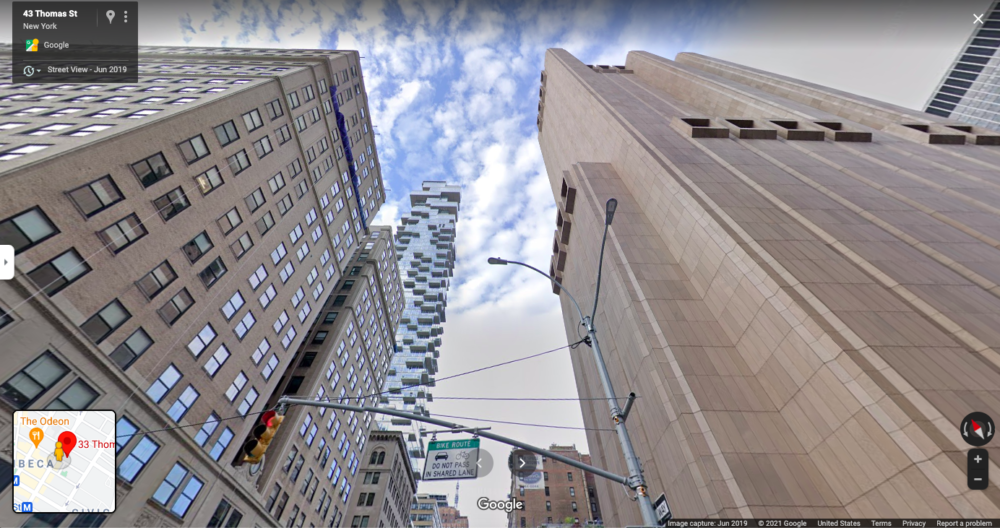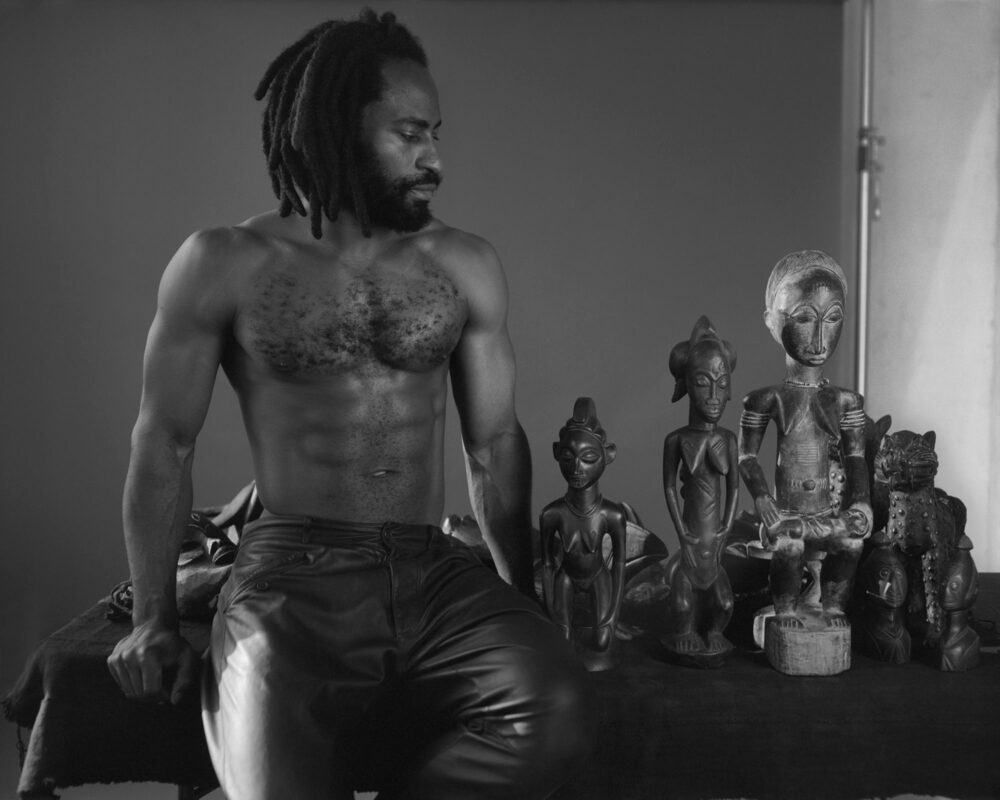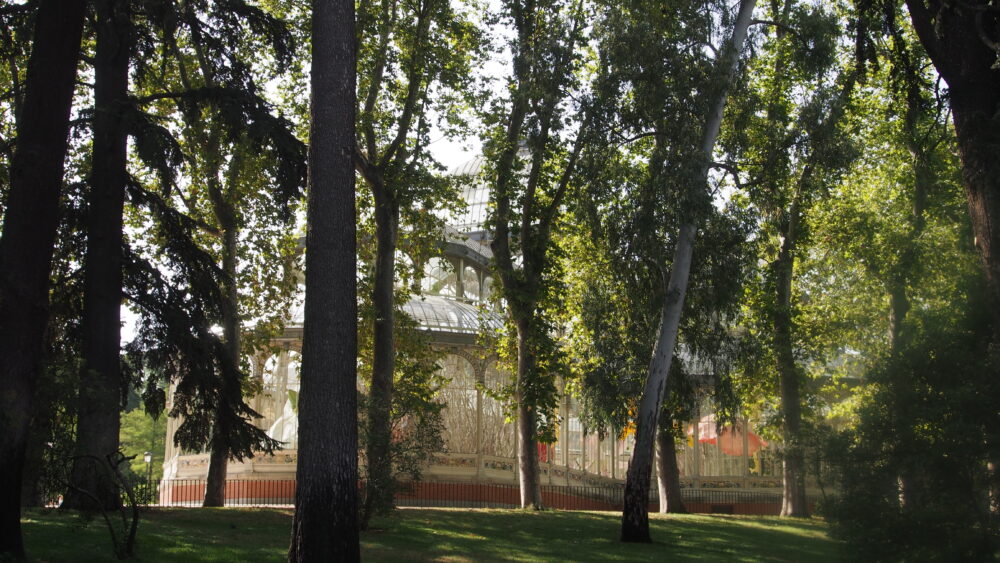Cover image: 33 Thomas from the intersection of Church and Worth. Image courtesy of Google Maps. A few blocks south of Canal Street in Tribeca,… Continue Reading Art and Surveillance: Hiding in Plain Sight
Posts published in “Photography”
A sidelong glance reveals as much as a direct gaze—which Hans Holbein the Younger humorously demonstrated in The Ambassadors (1533) by depicting a skull at… Continue Reading John Edmonds Gives Us Some Serious Side Eye
In "to a raven and the hurricanes which bring back smells of humans in love from unknown places," Petrit Halilaj’s vivid celebration of transcendent queer love takes on new resonance in the context of the global pandemic. Continue Reading On wingless birds and permeable cages: Petrit Halilaj at the Palacio de Cristal, Madrid
On December 2, 2014, University of Maryland Professor Joshua Shannon delivered a lecture entitled “Photorealism: A History of Surfaces” as part of the Institute of Fine Art’s Daniel H. Silberberg Lecture Series. (A recording of his talk can be viewed here.) The theme of the Silberberg lecture series this year is “failure,” and Professor Shannon’s presentation on photorealism took the failure of credibility suffered by humanist painting in the late twentieth century as a point of departure. IFA Ph.D. Candidate Claire Brandon interviewed Professor Shannon following the lecture.
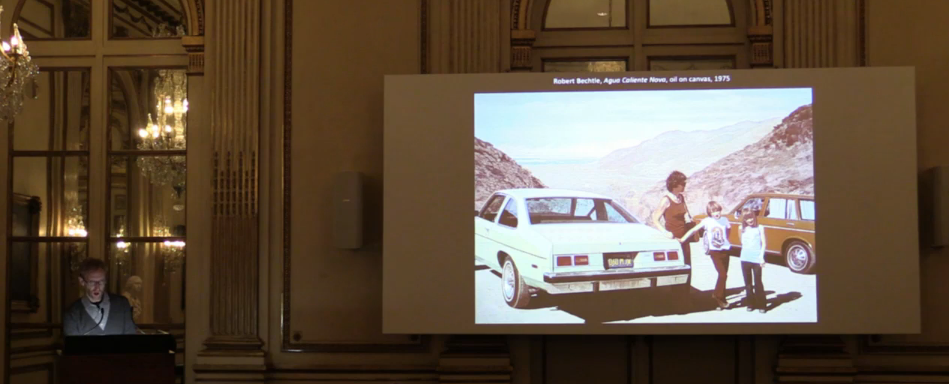
In the beginning of your lecture, you mentioned 1968 as the starting point for your study. What was happening with the practice of photorealism during that moment? How do you see it as marking such a major shift in painting?
Photorealism made a rather sudden appearance in painting in 1967-68. Most of the photorealists had been making other kinds of realist painting in the years just before then, but it is amazing to see how suddenly—and simultaneously—many of them began to make paintings that acknowledged, even exaggerated, the fact that that they were based on photographs. This struck me as a fact needing some historical explanation.
Why have you chosen to focus on Robert Bechtle? How can his work be differentiated from the other photorealists you brought up, such as Chuck Close, Richard Estes, and Ralph Goings?
I just think Bechtle made many of the richest and most revealing paintings. The photorealists are united by the fact that they all make clear that they have painted from photographs, but the kinds of photographs they work from are actually quite diverse. While Estes, for example, uses urban architectural photography and Close uses portrait photographs, Bechtle works from snapshots. His paintings are deliberately exploring amateur photography, even mediocre amateur photography. Bechtle is interested not so much in precision or in dryness as he is in posing. His paintings are about self-presentation, and about what counts as a good or meaningful picture. As such, Bechtle has his fingers on many of the most important problems in visual representation over the past several decades. We have so much to learn from his paintings.
All photographs date from the early 1960s through 1966.
In 1990, the South African court justice Albie Sachs famously penned an essay called “Preparing Ourselves For Freedom” in which he argued for a return to beauty in the arts, and an expansion of creativity beyond the decades of revolutionary cultural work aimed at supporting the anti-apartheid struggle. While the lifelong activist knew firsthand that political engagement had long been a matter of survival, he asserted that the repeated imagery of “fists, spears, and guns” might limit the creative imagination of the new South Africa, that “the range of themes is narrowed down so much that all that is funny or curious or genuinely tragic in the world is extruded. Ambiguity and contradiction are completely shut out.”[1] Be that as it may, there will always be those rare, inspired cases in which the political and the beautiful need not be mutually exclusive, where complexity and ambivalence are found in the most seemingly black-and-white circumstances. The work of South African photojournalist Ernest Cole (1940-1990) offers one such example. His work betrays a deep commitment to both social and aesthetic engagement, which come together in a stunning portfolio of photographs that documents life under apartheid and pays homage to the persistence of humanity through struggle.
Ernest Cole: Photographer, organized by the Hasselblad Foundation and currently on view at NYU’s Grey Art Gallery through December 6th, is the first museum retrospective of Ernest Cole’s work, and one that is long overdue. The artist risked his life and ultimately sacrificed his citizenship in order to produce his seminal photobook House of Bondage, which remains one of the most visually powerful and politically incisive documents of the apartheid era.
Cole considered it his life’s work to chronicle the black experience from every angle: public and private, at work and at home, and inclusive of the perspectives of men, women, children, and families. He envisioned his target audiences to be foreigners – Europeans and Americans – both in the hopes of revealing the horrors of apartheid to the outside world, and in full knowing that he would never be able to distribute his work domestically (even today, the book is less known in South Africa than it is in the West, having only been published in New York and London in 1967). Across this presentation of over one hundred images, shot throughout the 1960s, we bear witness to not only the gross indignities inflicted on black South Africans by the apartheid system, but also a collection of more intimate, everyday moments that humanize and honor Cole’s subjects.

At the Metropolitan’s hosting of the SFMOMA retrospective exhibition Garry Winogrand (on view June 27 to September 21, 2014), the photographer’s quotations sprinkled through the galleries convey his annoyingly literal way of answering questions about his work. For example: Why did he photograph? To see “how the thing looks photographed.” Art historians might want a meatier explanation, but Winogrand stubbornly maintained his answers, with evasions that can sometimes seem facetious. About his complex and undeniably incisive photograph Los Angeles, 1969, he claimed, “It’s the light. Look at the light!”
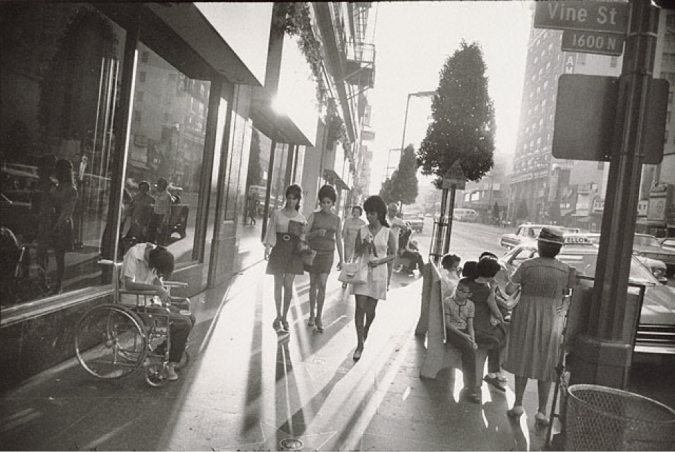
But wandering through the rooms of the exhibition eases any frustration with Winogrand. His photographs are masterful. They are slippery, unsettling, hilarious documents of the joys, pretensions, and tragedies of mid-century American life. While Winogrand is never quite cruel to his subjects, he is definitely unsparing. The loneliness of a new New Yorker, the sensuality of an uptown shopper, the strain of a tight swimsuit—even, in a winking move by the museum, the lasciviousness of a Met Centennial Ball attendee—all is documented.
As is fitting with his perfectionist manner, American photographer Christopher Williams took an active collaborative role in the design and installation of his career-spanning survey, Christopher Williams: The Production Line of Happiness (on view July 27 to November 2, 2014), at the Museum of Modern Art. First mounted at the Art Institute of Chicago, the exhibition currently resides at MoMA and travels next to the Whitechapel Gallery in London.
Visitors may be puzzled upon arriving in the entrance area outside the exhibition’s galleries. Instead of the typical introductory wall text and related visual references, the entrance walls are covered with liner notes from a recording and installation views from past exhibits. Similar to the recent Alibis: Sigmar Polke 1963-2010 retrospective at MoMA, wall labels have been replaced with a handout. This unconventional use of wall space and lack of information in the galleries are typical of Williams’s shows.

Through this installation at MoMA, Williams challenges the viewer by aiming to avoid a “neutralization” of his work within different spaces. Indeed, he has a history of using non-traditional display practices to create a consciousness of the institutional presentation of art. The artist began to develop his unique approach to display when studying at CalArts under Conceptualists Michael Asher, John Baldessari, and Douglas Huebler. Williams’s professors were renowned for creating architectural interventions and disruptions in museum and gallery shows as a way to complicate conventions of presentation.
The following is an abridged transcript of a conversation between IFA alumna Roxana Marcoci, Curator of Photography at The Museum of Modern Art, and the author, which took place at MoMA on 7 August 2012.


“[…] he mistook the curtains of the window of his room for a canvas, and he kept describing what he was painting: the colors, shapes, and shades.”[3]
On broad empty surfaces, marks begin to show—indicative of fragility, a sense of loss? Or expectation? Thought-full? Thought-less? Mannerisms coincide. A type of gestural painting that emerges out of contradictions. Too much, I felt, too much pathos. Yet architectonic enough to let that pathos live, consume, burn out. “The Fire that Consumes All before It” he wrote in a 1978 painting. The type of art that requires more of the viewer, becoming manifest only after the first impatient encounter is past.
In museums I often grow impatient. It happened with Twombly every single time, while secretly I was flirting with those scratches and scribbles and grays, seduced by the casual violence of raw color stacked atop the fibers, the mad mess that verged on spilling onto the clean white gallery walls. That whole magnificent period in the ‘50s during which his life and career intersected with those of Robert Rauschenberg and Jasper Johns intrigued me. Likewise, his subsequent move to Italy: rare expat, never to return from a strange form of self-imposed exile.

